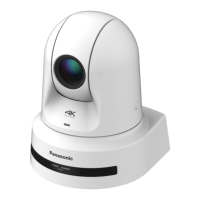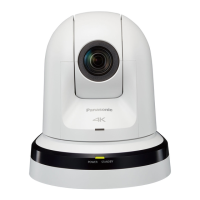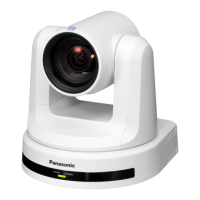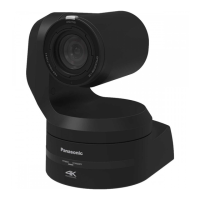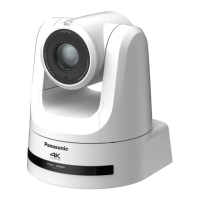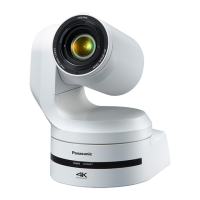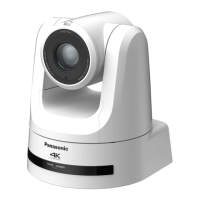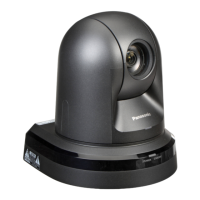Operating Instructions
Operating precautions
Do not use the unit in oily-smoky or dusty
places.
Performance may be adversely affected if small particles or other
foreign objects get inside the product.
Take extra care in environments where a special effect such as
theatrical smoke is used.
Do not allow foreign matter to make contact
with the rotating parts.
Failure to obey may cause the unit to malfunction.
Maintenance
Turn off the unit’s power before proceeding with maintenance.
Failure to obey may result in injuries.
Wipe the surfaces using a soft dry cloth. Avoid all contact with
benzine, paint thinners and other volatile substances, and avoid
using these substances. Otherwise, the casing may become
discolored.
Hold the bottom surface with both hands for
picking up this unit.
If you hold the lens part or the sides, it will put a load strain on the
motor and cause a malfunction.
Do not turn the camera head by hand.
Turning the camera head by hand may cause the unit to
malfunction.
About the lens/pan-tilt head
If the lens, pan-tilt head, and other parts are not operated for a long
period of time, the viscosity of the grease applied inside them may
increase and operation may become no longer possible. Move the
lens and pan/tilt head regularly.
Shoot under the proper lighting conditions.
To produce pictures with eye-pleasing colors, shoot under the
proper lighting conditions.
The pictures may not appear with their proper colors when shooting
under fluorescent lights. Select the proper lighting as required.
To ensure a stable performance in the long
term
Using the unit for prolonged periods in locations where the
temperature and humidity levels are high will cause its parts to
deteriorate, resulting in a reduction of its service life.
(Recommended temperature: Max. 35 °C (95 °F))
Ensure that a cooling unit or heating unit will not blow any air
directly toward the installation location.
Do not point the camera at
strong lights.
When parts of the MOS sensor are
exposed to spotlights or other strong
lights, blooming (a phenomenon where
the edges of strong lights become
blurred) may occur.
Bright subject
Blooming
What happens with high-brightness subjects
Flare may occur if an extremely bright light source is pointed at
the lens. In a case like this, change the angle or take some other
remedial action.
When using the automatic functions
• In the [Scene] such as the camera menu, the initial settings on
some items has been set to auto, making it impossible for these
items to be operated manually. To operate them manually, switch
from the auto settings to the manual settings as required.
• When using the ATW (auto tracking white adjustment) function
under fluorescent lights, the white balance may vary.
• In some situations, it may be hard to focus at the auto setting. In
cases like this, select the manual setting, and focus manually.
Zooming and focusing
When the focus is set manually, out-of-focusing may occur during
zooming.
After zooming, if necessary, either adjust the focus or set the focus
to auto.
When using the focus at the manual setting, proceed with zooming
after setting the focus position at the Tele end where the focusing
accuracy is higher. (However, if the distance from the unit to the
subject is less than 1.2 meters (3.9 ft), the subject may shift out of
focus at the Wide end.)
If zooming is performed to the Tele end after having adjusted the
focus at the Wide end, out-of-focusing may occur.
Operation of the lens when the power is turned
on
When the unit’s power is turned on, the zoom, focus and iris are
adjusted automatically.
The unit comes with the safe mode.
The safe mode is function designed to protect the unit from damage.
For details, refer to the Operating Instructions (PDF) → “Safe
mode”.
Concerning the HDMI interface standard
This unit has been certified as HDMI-compatible, but on rare
occasions images may not be displayed depending on the HDMI
device which has been connected to the unit.
Color bars
Color bars are used to adjust the color phase, and the widths and
positions of these bars may differ from other models.
H.264/H.265 patent pool licensing
This product is licensed based on the AVC Patent Portfolio License,
and the license does not extend beyond uses by users, who engage
in the acts described below, for their own personal and non-profit
applications.
(i) Recording of image information in compliance with the AVC
standard (hereafter, “AVC videos”)
(ii) Playing of AVC videos recorded by consumers engaging
in personal activities or AVC videos acquired from licensed
providers
For details, visit MPEG LA, LLC website (http://www.mpegla.com).
Concerning PoE++ power supply
The unit complies with the IEEE 802.3bt.
Use a compatible Ethernet hub and PoE++ injector to use a PoE++
power supply.
Software authentication (LLDP) complies with IEEE 802.3bt, but it
may be necessary to make settings on the network device.
For details on Ethernet hubs and PoE++ injectors for which
operations have been verified, consult your local dealer.
44
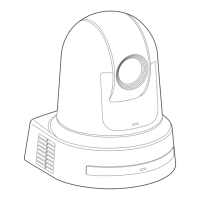
